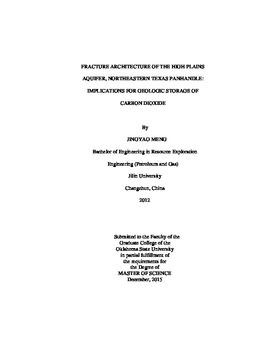| dc.contributor.advisor | Pashin, Jack C. | |
| dc.contributor.author | Meng, Jingyao | |
| dc.date.accessioned | 2016-09-29T18:45:53Z | |
| dc.date.available | 2016-09-29T18:45:53Z | |
| dc.date.issued | 2015-12-01 | |
| dc.identifier.uri | https://hdl.handle.net/11244/45366 | |
| dc.description.abstract | Surface and airborne gas monitoring programs are becoming an important part of environmental protection in areas favorable for subsurface storage of carbon dioxide. Understanding structural architecture and its effects on the flux of fluids, specifically CO2 and CH4, in the shallow subsurface and atmosphere is helping design and implement next generation monitoring technologies, including unmanned aerial vehicles (UAVs). An important aspect of this research is using subsurface fracture data to inform the design of flight pathways for UAVs in the Farnsworth Oil Unit of the Anadarko Basin. The High Plains Aquifer of the northeastern Texas Panhandle disconformably overlies Permian and Triassic redbeds and is dominated by weakly to moderately indurated sandstone in the Ogallala Formation. Ogallala strata are overlain by Quaternary strata that include chert and caliche caprock. The target zone for CO2 storage and enhanced oil recovery in the Farnsworth Oil Unit is in upper Morrow sandstone at subsurface depths greater than 2,000 m. Field study reveals that indurated sandstone and chert contain numerous joints that provide crucial insight into aquifer architecture and subsurface flow pathways.Properties of more than 1,700 joints were measured in the field and in high-resolution satellite imagery. The joint networks consist of well-developed systematic joints and cross-joints. In vertical section, the joints are typically curvilinear and strata-bound. Two distinctive joint systems were identified in the study area. Joint spacing follows a log-normal statistical scaling rule. These fractures appear to be the product of regional tectonic stress and may have a significant effect on flow in the High Plains Aquifer system. Based on the results of this research, design of UAV flight paths should be oblique to fractures in a way that maximizes the likelihood of CO2 and CH4 flux from systematic joints and cross joints. Geological risk of leakage from CO2-enhanced oil recovery operations at Farnsworth is low, and multiple potential natural sources of CO2 and CH4 have been identified in near-surface formations. These near-surface sources are predicted to dominate shallow subsurface and atmospheric gas flux. | |
| dc.format | application/pdf | |
| dc.language | en_US | |
| dc.rights | Copyright is held by the author who has granted the Oklahoma State University Library the non-exclusive right to share this material in its institutional repository. Contact Digital Library Services at lib-dls@okstate.edu or 405-744-9161 for the permission policy on the use, reproduction or distribution of this material. | |
| dc.title | Fracture Architecture of the High Plains Aquifer, Northeastern Texas Panhandle:Implications for Geologic Storage of Carbon Dioxide | |
| dc.type | text | |
| dc.contributor.committeeMember | La� D�vila, Daniel A. | |
| dc.contributor.committeeMember | Abdelsalam, Mohamed G. | |
| osu.filename | Meng_okstate_0664M_14273.pdf | |
| osu.accesstype | Open Access | |
| dc.description.department | Geology | |
| dc.type.genre | Thesis | |
